[ad_1]
Due to the risk of Unrecoverable Read Errors (UREs) when restoring an unsuccessful disk, RAID 5 is hardly ever utilized nowadays. Besides, one URE might create the whole selection to fall short.
RAID 6 or RAID 10 are normally advised as more secure options. Yet these RAID degrees have actually specific negative aspects contrasted to RAID 5. And also with exactly how big RAID varieties have obtained nowadays, they can in some cases be poor too.
So, is RAID 5 ever before worth utilizing nowadays? Or should you constantly choose greater degrees like RAID 10 regardless of their disadvantages? We’ll attempt to address such questions in this write-up.
What is RAID 5?
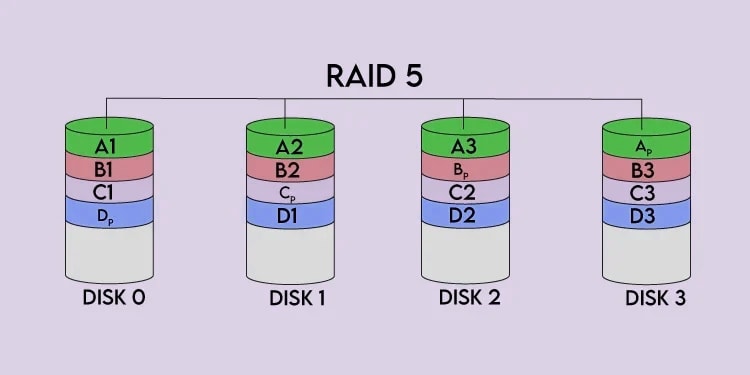
RAID 5 is a conventional RAID degree that red stripes block-sized portions of information throughout the selection. It utilizes one disk well worth of room to shop parity information which is dispersed throughout the selection. Therefore, RAID 5 supplies an excellent mix of whatever (efficiency, mistake resistance, storage space capability).
- Superb functional storage space
- Good for read-intensive workloads
- Somewhat bad compose performance
- Can just maintain one disk failure
- Long reconstruct time
What is RAID 10?
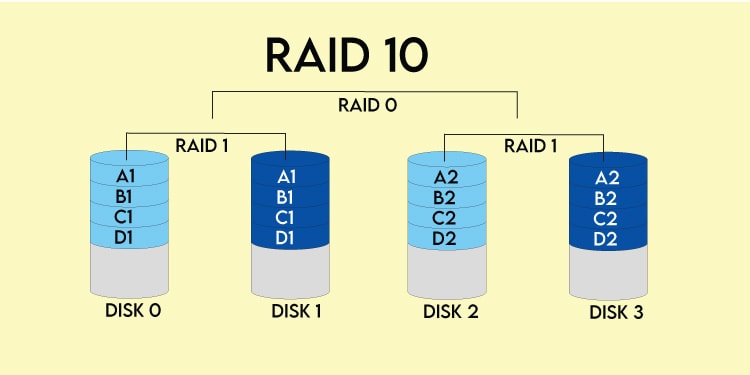
RAID 10, or practically RAID 1 +0, is an embedded RAID degree. It integrates RAID 1 (matching just) as the very first layer and also RAID 0 (striping just) as the 2nd layer. Therefore, it’s additionally called a red stripe of mirrors.
Like RAID 5, RAID 10 additionally red stripes information portions at the block degree. Yet it utilizes matching rather than parity estimation for mistake resistance. And also unlike RAID 5 which is a jack-of-all-trades, RAID 10 focuses on efficiency and also redundancy over storage space performance.
- Superb compose performance
- Can possibly deal with several disk failures
- Just 50% functional storage
- Larger RAID 10 varieties are costly
RAID 5 Vs RAID 10– Key Differences
RAID 5 and also RAID 10 vary in considerable means, with the major one being exactly how they supply mistake resistance, and also to what level.
Mistake Tolerance
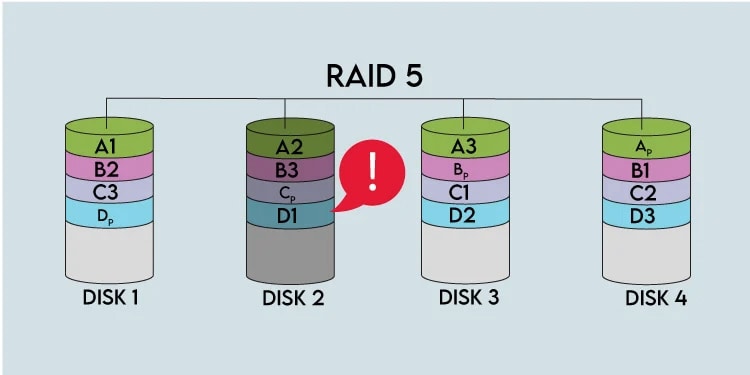
RAID 5 computes parity info by executing XOR procedures on each byte of information. It disperses this parity information throughout the selection such that it inhabits one disk well worth of room general.
If a disk in the selection falls short and also requires to be changed, this parity information, in addition to the presently practical disks, can be utilized to rebuild the shed information. Many thanks to this, RAID 5 varieties can maintain one disk failing.
RAID 10 utilizes matching rather than parity estimation to supply mistake resistance. Given that the reduced layers are mirrored sets of disks (RAID 1), each RAID 1 selection can maintain approximately 1 disk failing. On the whole, this suggests that RAID 10’s mistake resistance degree differs a great deal.
Let’s claim you have a 12-disk RAID 10 selection. Your selection could deal with approximately 6 simultaneous disk failings, or it could fall short since both disks in the exact same RAID 1 selection stopped working. In the best-case circumstance, RAID 10’s mistake resistance can be unparalleled. In the most awful instance, it’ll coincide as RAID 5.
Also if just one disk falls short, RAID 10 has a tendency to make out much better when restoring, specifically with bigger varieties. This is since RAID 5 requires to review information off all disks in the selection, while RAID 10 only manage one mirrored set.
Read/Write Performance

Read and also compose rates normally depend upon what your work mainly appears like. RAID 10 takes care of arbitrary I/O much better since it has 2 the same datasets to collaborate with, which helps in reducing look for time.
With consecutive I/O though, RAID 5 supplies similar efficiency. For read-intensive work, we have actually also seen situations where RAID 5 executed much better. Yet compose efficiency is a various tale.
RAID 5 computes and also composes one portion of parity for each and every red stripe of information. This expenses causes reduced compose efficiency. RAID 10 practically requires to compose information two times as a result of matching, yet since the composes are performed in parallel on 2 various drives, there’s no overhanging.
Therefore, RAID 10 victories in regards to compose efficiency, also when managing consecutive I/O.
Minimum Disks
RAID 5 needs a minimum of 2 disks for striping and also one disk well worth of room to shop parity information. This suggests any kind of RAID 5 selection needs 3 disks at the minimum. Past that, you can include as lots of disks as you would certainly such as.
RAID 10 red stripes mirrored sets, indicating you’ll require an also variety of complete disks. In addition, a conventional RAID 10 selection needs a minimum of 4 disks (2 for matching, and also 2 even more to red stripe the mirrored selection). Some non-standard applications like Linux MD do sustain RAID 10 with as couple of as 2 disks though.
Functional Storage
A RAID 5 selection books just one disk well worth of room for parity information. This isn’t wonderful for redundancy, yet likewise, it’s superb in regards to storage space performance. This declaration rings also more accurate with bigger RAID 5 varieties.
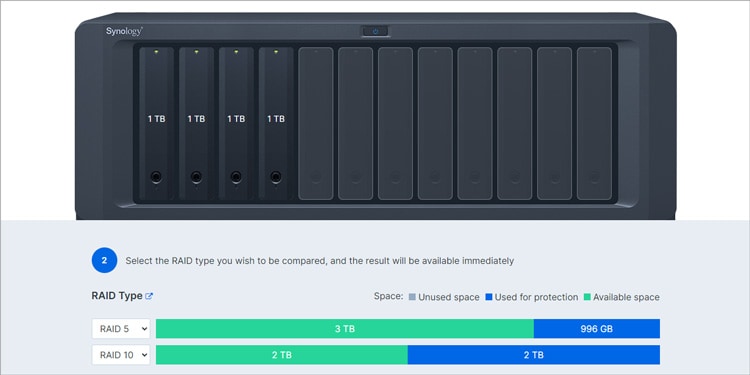
RAID 10 is the contrary. As it utilizes mirrored sets, just 50% of the complete storage space is functional as the remainder is required for redundancy. With big varieties, this causes a considerable quantity of pointless room. Yet likewise, you additionally obtain possibly unparalleled mistake resistance.
Just how Are RAID 5 and also RAID 10 Comparable?
We have actually currently covered the major distinctions in between RAID 5 and also RAID 10, yet there are additionally some resemblances suitable to both of them. For beginners, you can execute both of these utilizing equipment or software application suggests.
When establishing either of these RAID degrees, you must make use of same-size disks to make best use of functional storage space. Utilizing combined dimensions disks causes a traffic jam, as shown listed below.
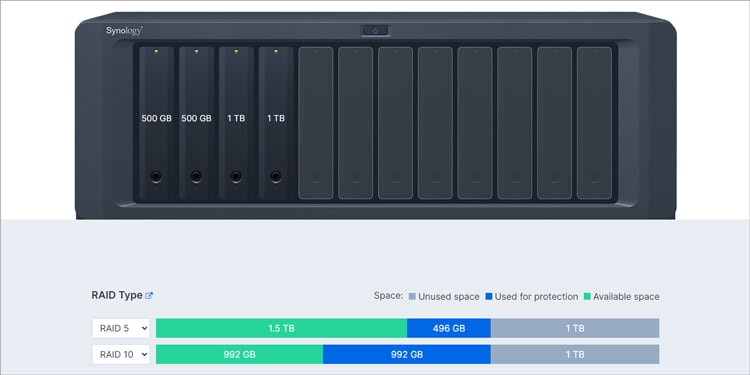
In addition, normal disk scrubbing up will considerably enhance the dependability of your RAID configuration, despite which certain degree you choose.
Should You Make use of RAID 5?
RAID 5 is extremely storage-efficient, and also in-turn, affordable. This makes it an excellent alternative for small or individual use. RAID 5 takes care of consecutive work well as lengthy as it isn’t exceedingly I/O extensive. This makes it ideal for points like media web servers, data web servers, and also back-ups.
It can additionally be an affordable service when you require to establish a huge selection. Yet as RAID 5’s dependability lowers with a rise in range, you’ll require to evaluate the benefits and drawbacks to make your choice.
When is RAID 10 Better?
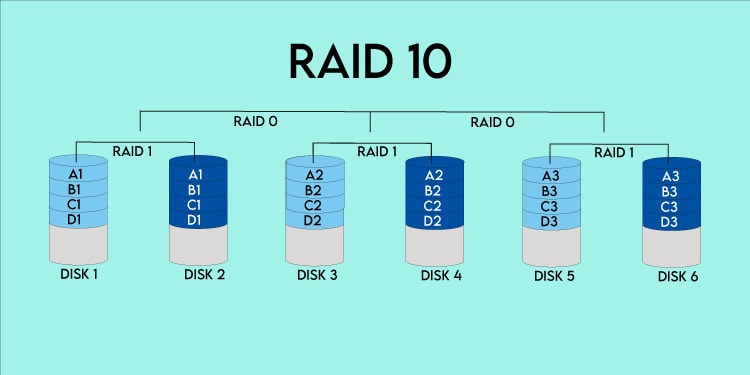
For write-heavy and also I/O-intensive work, RAID 10 is the much better alternative. It’s extremely typically utilized for SQL web servers. Along with data source web servers, it’s additionally ideal for points like e-mail web servers, internet servers, and so on
If safety and security and also efficiency are the top priority, RAID 10 is an outstanding alternative. Yet as just half the storage room is functional, establishing big RAID 10 varieties can be a pricey challenge. Just like RAID 5, you’ll require to make your choice based upon your major demands and also budget plan.
Last Decision– RAID 5 Vs RAID 10
When contrasting RAID 5 and also RAID 10, one isn’t globally much better or even worse than the various other. It’s even more regarding what you intend to utilize your RAID configuration for. Usually talking, RAID 5 is an all-round and also obtainable alternative for the majority of people. RAID 10 is much better when information accessibility and also efficiency are the major top priorities.
No matter which you choose however, bear in mind that RAID’s function is uptime. RAID!= backup.
Good techniques can lessen the possibility of information loss when utilizing RAID, yet despite any one of the ‘more secure’ RAID applications, information loss is constantly an opportunity. A different exterior, and also preferably offsite, back-up is the very best security versus this.
To summarize, right here are the major distinctions in between RAID 5 Vs RAID 10:
| RAID 5 | RAID 10 | |
| Fault Tolerance | Can maintain one disk failing. | Can maintain failing of one to half the disks in the selection. |
| Performance | Decent reviewed efficiency with consecutive I/O. | Superb compose efficiency and also similar read efficiency. |
| Variety of Disks | Need 3 disks at minimal. | Required 4 disks at minimal. |
| Functional Storage | Parity information inhabits room comparable to one disk. | Just 50% storage space is functional general. |
.



